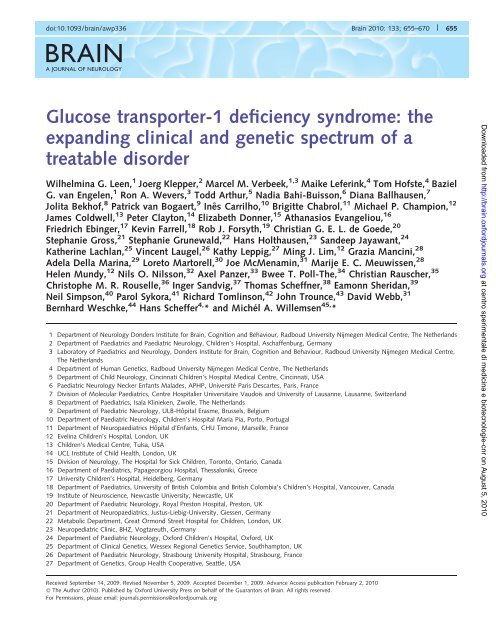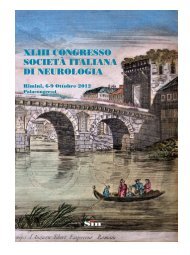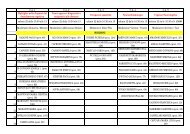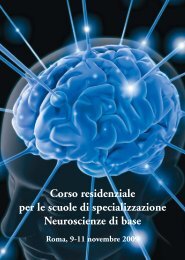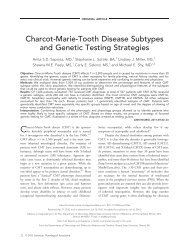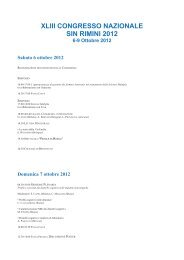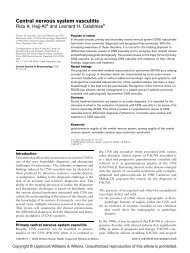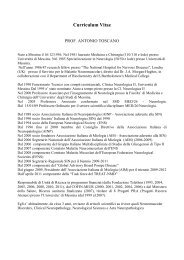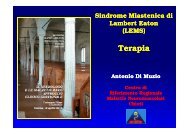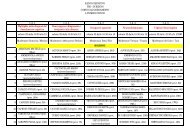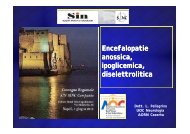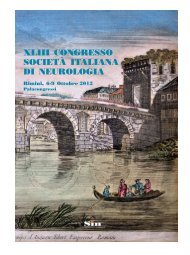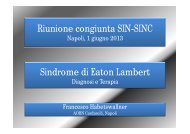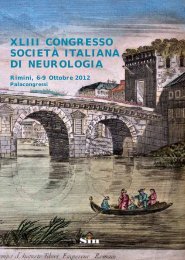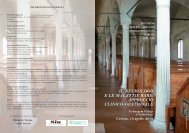Glucose transporter-1 deficiency syndrome: the expanding clinical ...
Glucose transporter-1 deficiency syndrome: the expanding clinical ...
Glucose transporter-1 deficiency syndrome: the expanding clinical ...
- No tags were found...
Create successful ePaper yourself
Turn your PDF publications into a flip-book with our unique Google optimized e-Paper software.
doi:10.1093/brain/awp336 Brain 2010: 133; 655–670 | 655BRAINA JOURNAL OF NEUROLOGY<strong>Glucose</strong> <strong>transporter</strong>-1 <strong>deficiency</strong> <strong>syndrome</strong>: <strong>the</strong><strong>expanding</strong> <strong>clinical</strong> and genetic spectrum of atreatable disorderWilhelmina G. Leen, 1 Joerg Klepper, 2 Marcel M. Verbeek, 1,3 Maike Leferink, 4 Tom Hofste, 4 BazielG. van Engelen, 1 Ron A. Wevers, 3 Todd Arthur, 5 Nadia Bahi-Buisson, 6 Diana Ballhausen, 7Jolita Bekhof, 8 Patrick van Bogaert, 9 Inês Carrilho, 10 Brigitte Chabrol, 11 Michael P. Champion, 12James Coldwell, 13 Peter Clayton, 14 Elizabeth Donner, 15 Athanasios Evangeliou, 16Friedrich Ebinger, 17 Kevin Farrell, 18 Rob J. Forsyth, 19 Christian G. E. L. de Goede, 20Stephanie Gross, 21 Stephanie Grunewald, 22 Hans Holthausen, 23 Sandeep Jayawant, 24Ka<strong>the</strong>rine Lachlan, 25 Vincent Laugel, 26 Kathy Leppig, 27 Ming J. Lim, 12 Grazia Mancini, 28Adela Della Marina, 29 Loreto Martorell, 30 Joe McMenamin, 31 Marije E. C. Meuwissen, 28Helen Mundy, 12 Nils O. Nilsson, 32 Axel Panzer, 33 Bwee T. Poll-The, 34 Christian Rauscher, 35Christophe M. R. Rouselle, 36 Inger Sandvig, 37 Thomas Scheffner, 38 Eamonn Sheridan, 39Neil Simpson, 40 Parol Sykora, 41 Richard Tomlinson, 42 John Trounce, 43 David Webb, 31Bernhard Weschke, 44 Hans Scheffer 4, * and Michél A. Willemsen 45, *1 Department of Neurology Donders Institute for Brain, Cognition and Behaviour, Radboud University Nijmegen Medical Centre, The Ne<strong>the</strong>rlands2 Department of Paediatrics and Paediatric Neurology, Children’s Hospital, Aschaffenburg, Germany3 Laboratory of Paediatrics and Neurology, Donders Institute for Brain, Cognition and Behaviour, Radboud University Nijmegen Medical Centre,The Ne<strong>the</strong>rlands4 Department of Human Genetics, Radboud University Nijmegen Medical Centre, The Ne<strong>the</strong>rlands5 Department of Child Neurology, Cincinnati Children’s Hospital Medical Centre, Cincinnati, USA6 Paediatric Neurology Necker Enfants Malades, APHP, Université Paris Descartes, Paris, France7 Division of Molecular Paediatrics, Centre Hospitalier Universitaire Vaudois and University of Lausanne, Lausanne, Switzerland8 Department of Paediatrics, Isala Klinieken, Zwolle, The Ne<strong>the</strong>rlands9 Department of Paediatric Neurology, ULB-Hôpital Erasme, Brussels, Belgium10 Department of Paediatric Neurology, Children’s Hospital Maria Pia, Porto, Portugal11 Department of Neuropaediatrics Hôpital d’Enfants, CHU Timone, Marseille, France12 Evelina Children’s Hospital, London, UK13 Children’s Medical Centre, Tulsa, USA14 UCL Institute of Child Health, London, UK15 Division of Neurology, The Hospital for Sick Children, Toronto, Ontario, Canada16 Department of Paediatrics, Papageorgiou Hospital, Thessaloniki, Greece17 University Children’s Hospital, Heidelberg, Germany18 Department of Paediatrics, University of British Colombia and British Colombia’s Children’s Hospital, Vancouver, Canada19 Institute of Neuroscience, Newcastle University, Newcastle, UK20 Department of Paediatric Neurology, Royal Preston Hospital, Preston, UK21 Department of Neuropaediatrics, Justus-Liebig-University, Giessen, Germany22 Metabolic Department, Great Ormond Street Hospital for Children, London, UK23 Neuropediatric Clinic, BHZ, Vogtareuth, Germany24 Department of Paediatric Neurology, Oxford Children’s Hospital, Oxford, UK25 Department of Clinical Genetics, Wessex Regional Genetics Service, Southhampton, UK26 Department of Paediatric Neurology, Strasbourg University Hospital, Strasbourg, France27 Department of Genetics, Group Health Cooperative, Seattle, USADownloaded from http://brain.oxfordjournals.org at centro sperimentale di medicina e biotecnologie-cnr on August 5, 2010Received September 14, 2009. Revised November 5, 2009. Accepted December 1, 2009. Advance Access publication February 2, 2010ß The Author (2010). Published by Oxford University Press on behalf of <strong>the</strong> Guarantors of Brain. All rights reserved.For Permissions, please email: journals.permissions@oxfordjournals.org
Clinical and genetic spectrum of GLUT1DS Brain 2010: 133; 655–670 | 657Introduction<strong>Glucose</strong> <strong>transporter</strong>-1 (GLUT1) <strong>deficiency</strong> <strong>syndrome</strong> (OMIM#606777) is an autosomal dominant haplo-insufficiency disorder,leading to a reduced glucose transport into <strong>the</strong> brain (Seidneret al., 1998). GLUT1 is highly expressed in <strong>the</strong> endo<strong>the</strong>lial cellsof erythrocytes and <strong>the</strong> blood-brain barrier and is exclusivelyresponsible for glucose transport into <strong>the</strong> brain (Vannucci et al.,1997; Barros et al., 2007). GLUT1 <strong>deficiency</strong> <strong>syndrome</strong> was firstdescribed in 1991 by De Vivo et al. (1991). The classic patientwith GLUT1 <strong>deficiency</strong> <strong>syndrome</strong> presents with infantiledrug-resistant seizures, mild to severe developmental delay andan acquired microcephaly in up to 50% of <strong>the</strong> cases. Hypotonia,spasticity, ataxia and dystonia are elements of a complex movementdisorder (Klepper and Leiendecker, 2007). In recent years,however, is has become apparent that <strong>the</strong> <strong>clinical</strong> spectrum ofGLUT1 <strong>deficiency</strong> <strong>syndrome</strong> is much broader (Brockmann,2009). Patients with a non-classical phenotype featuring developmentaldelay and movement disorders without epilepsy have beendescribed (Overweg-Plandsoen et al., 2003; Hennecke et al.,2005; Friedman et al., 2006; Klepper et al., 2007), as well asfamilial and sporadic paroxysmal exercise induced dyskinesiawith or without epilepsy (Suls et al., 2008; Weber et al., 2008;Schneider et al., 2009).When GLUT1 <strong>deficiency</strong> <strong>syndrome</strong> is suspected on <strong>clinical</strong>grounds, a lumbar puncture in <strong>the</strong> fasting state should be performed.GLUT1 <strong>deficiency</strong> <strong>syndrome</strong> is characterized by a lowglucose concentration in <strong>the</strong> cerebrospinal fluid (hypoglycorrhachia)in <strong>the</strong> absence of hypoglycaemia, in combination with alow to normal lactate in <strong>the</strong> cerebrospinal fluid (Klepper et al.,1999b; Klepper and Voit, 2002). It is important to recognizeGLUT1 <strong>deficiency</strong> <strong>syndrome</strong>, since <strong>the</strong> disorder can be treatedwith a ketogenic diet. Ketone bodies use ano<strong>the</strong>r <strong>transporter</strong> toenter <strong>the</strong> central nervous system and thus can supply <strong>the</strong> brainwith an alternative fuel.In most patients <strong>the</strong> ketogenic diet markedly reduces <strong>the</strong> frequencyof seizures (Klepper et al., 2005) and <strong>the</strong> severity of <strong>the</strong>movement disorder (Brockmann, 2009). Behaviour and alertnessalso frequently improve (Klepper et al., 2005, 2007; Joshi et al.,2008).For <strong>the</strong> diagnosis of GLUT1 <strong>deficiency</strong> <strong>syndrome</strong>, GLUT1 westernblot analysis in erythrocyte membranes and glucose uptakeinto erythrocytes can be applied to determine GLUT1 function.Negative western blots or erythrocyte uptake studies, however,do not rule out <strong>the</strong> diagnosis (Klepper et al., 1999a). GLUT1 <strong>deficiency</strong><strong>syndrome</strong> can be confirmed by mutation analysis of <strong>the</strong>SLC2A1 gene. The SLC2A1 gene, mapped to <strong>the</strong> short arm ofchromosome 1 (1p35-31.3) (Shows et al., 1987), is a relativelysmall gene and consists of ten exons, spanning 2842 base pairsencoding 493 amino acids (Fukumoto et al., 1988).The structure and function of <strong>the</strong> GLUT1 protein has beenintensively investigated (Hruz and Mueckler, 2001). Theamino-acid sequence of <strong>the</strong> GLUT1 protein is highly conserved,with 97–98% identity between <strong>the</strong> human, rat, rabbit, mouseand pig sequences, which implies that all domains of this proteinare functionally important (Baldwin, 1993). GLUT1 has12 transmembrane alpha-helices (Mueckler et al., 1985), separatedby a large intracellular loop between helices 6 and 7. A 3D modelfor GLUT1 has been proposed, predicting a central aqueouschannel communicating <strong>the</strong> extracellular and intracellular compartments,with many residues crucial for glucose transport locatedaround this central channel (Mueckler and Makepeace, 2009).Since <strong>the</strong> first description of GLUT1 <strong>deficiency</strong> <strong>syndrome</strong> and<strong>the</strong> elucidation of its genetic cause, a wide spectrum of around 60different mutations in <strong>the</strong> SLC2A1 gene has been described inapproximately 100 patients (Wang et al., 2005; Klepper andLeiendecker, 2007), including large-scale deletions, missense, nonsense,frame shift and splice-site mutations. All mutations ei<strong>the</strong>rlead to absence or loss of function of one of <strong>the</strong> SLC2A1 alleles.Several hot spots for recurrent mutations have been identified(Asn34, Gly91, Ser113, Arg126, Arg153, Arg264, Thr295,Arg333) (Klepper and Leiendecker, 2007). Thus far, correlationsbetween phenotype and genotype remained elusive (Wang et al.,2005; Brockmann, 2009). Here we report on <strong>the</strong> genetic, biochemicaland <strong>clinical</strong> characteristics of 57 newly diagnosed patientswith GLUT1 <strong>deficiency</strong> <strong>syndrome</strong>.Materials and methodsPatientsFrom January 2004 to July 2008 <strong>the</strong> DNA Diagnostics Laboratory(Department of Human Genetics of <strong>the</strong> Radboud UniversityNijmegen Medical Centre, The Ne<strong>the</strong>rlands) received 132 requestsfor mutational analysis of <strong>the</strong> SLC2A1 gene in patients suspected tohave GLUT1 <strong>deficiency</strong> <strong>syndrome</strong> from all over <strong>the</strong> world (excluding<strong>the</strong> requests for carrier testing in parents and o<strong>the</strong>r family members ofaffected patients). In 54 patients (41%) suspicion of GLUT1 <strong>deficiency</strong><strong>syndrome</strong> was confirmed by <strong>the</strong> identification of a pathogenic mutationin <strong>the</strong> SLC2A1 gene. Additionally, we identified a mutation in <strong>the</strong>SLC2A1 gene in three <strong>clinical</strong>ly affected family members, bringing <strong>the</strong>total number of patients with GLUT1 <strong>deficiency</strong> <strong>syndrome</strong> confirmedby mutation analysis to 57. Clinical data were retrospectively collectedfrom referring physicians by means of a written, detailed questionnaire.Results were reviewed against <strong>the</strong> background of <strong>the</strong> existingliterature on SLC2A1 gene mutations and associated phenotypes.Mutation analysisGenomic DNA was extracted from blood samples by standard procedures.Automated Sanger sequencing was performed to study <strong>the</strong>entire coding sequence including at least 20 base pairs of intronicsequence flanking each exon of <strong>the</strong> SLC2A1 gene. Polymerase chainreaction (PCR) amplification of all 10 exons of <strong>the</strong> SLC2A1 gene wasperformed using Fast PCR Master Mix (Applied Biosystems, FosterCity, California, USA). Primer sequences are available upon request.Sequencing reactions were carried out using BigDye V. 3.1 (AppliedBiosystems) and analysed on an ABI 3730 capillary sequencer (AppliedBiosystems). Sequences were compared to <strong>the</strong> wild-type sequence assubmitted to Genbank (Genbank Accession Number NM_006516). Allpreviously unreported mutations were verified in a panel of at least100 control alleles. The reference sequence was used in which <strong>the</strong> A of<strong>the</strong> ATG start-codon is designated position 1. Amino-acid residueswere numbered from <strong>the</strong> first methionine residue; according to <strong>the</strong>protein accession number NP_006507.Downloaded from http://brain.oxfordjournals.org at centro sperimentale di medicina e biotecnologie-cnr on August 5, 2010
658 | Brain 2010: 133; 655–670 W. G. Leen et al.Single or multiple exon deletions or duplications of <strong>the</strong> SLC2A1 geneusing multiplex ligation-dependent probe amplification were analysedin all patients. Multiplex ligation-dependent probe amplification is atechnique for measuring allele dosage and identifies <strong>the</strong> targetsequence by hybridization of two adjacent complementary probes(Schouten et al., 2002). Multiplex ligation-dependent probe amplificationwas carried out using <strong>the</strong> SALSA MLPA kit P138 SLC2A1 (MRCHolland, Amsterdam, The Ne<strong>the</strong>rlands) according to <strong>the</strong> manufacturer’sinstructions. A visual comparison of <strong>the</strong> peak profiles wasmade to identify copy number changes. Heterozygous deletions ofprobe recognition sequences should give 35–50% reduced relativepeak area of <strong>the</strong> amplification product of that probe.Statistical analysisStatistical analyses were performed using Statistical Package for <strong>the</strong>Social Sciences version 16.0 (SPSS INC, Chicago, IL, USA). Mean differencesin CSF parameters between patients with a different genotypeor phenotype were assessed by means of analysis of variance(one-way ANOVA) using planned contrasts for group comparisons.Correlation between phenotype and genotype was tested using <strong>the</strong>Pearson Chi square test (two-sided testing for a significance level ofP 4 0.05).ResultsMolecular dataOut of 57 patients, 6 (11%) were identified with a multiple exondeletion of <strong>the</strong> SLC2A1 gene detected by multiplexligation-dependent probe amplification. In 51 patients a pathogenicmutation in <strong>the</strong> SLC2A1 gene was identified by DNAsequence analysis (Table 1). We identified 37 different novelpathogenic mutations, including 13 missense, 5 nonsense,13 frame shift, 4 splice and 2 translation initiation mutations. Weidentified two different de novo mutations in amino-acid residue1 (c.1A4G and c.3G4A). Since <strong>the</strong> mutations were located in <strong>the</strong>transcription codon of <strong>the</strong> SLC2A1 gene, transcription was notinitiated, which is consistent with haplo-insufficiency. We identified17 different missense mutations in <strong>the</strong> SLC2A1 gene, 13 ofwhich were novel. Eleven novel missense mutations wereidentified in patients with <strong>the</strong> classical phenotype of GLUT1 <strong>deficiency</strong><strong>syndrome</strong> of epilepsy and mental retardation in combinationwith movement disorders (p.Asn34Tyr, p.Met96Val, p.Ala155Val,p.Arg212Cis, p.Arg212His, p.Arg223Trp, p.Glu329Gln,p.Arg333Gln, p.Gly382Asp, p.Ala405Asp, p.Pro485Leu). Thenovel missense mutation p.Arg153His was identified in Patient 48with <strong>the</strong> non-classical phenotype of mild mental retardation withcontinuous ataxia and paroxysmal dystonia and choreoa<strong>the</strong>tosis.CSF in this patient showed a characteristic pattern of low CSF glucose(1.8 mmol/l) in combination with low CSF : blood glucose ratio(0.38) and low CSF lactate (1.0 mmol/l). The novel missense mutationp.Val303Leu was identified in Patient 57. This patient was lostas follow-up and <strong>clinical</strong> data were unavailable. DNA of <strong>the</strong> parentsof this patient was not investigated.All previously unreported mutations were verified in a panel ofat least 100 control alleles. Mutations were not mentionedas non-pathogenic polymorphism in <strong>the</strong> Single NucleotidePolymorphism database. Two mutation prediction programs wereused to predict <strong>the</strong> pathogenicity of mutations [PolyPhen(Polymorphism Phenotyping) and SIFT (Sorting Intolerant fromTolerant)]. The mutations that we identified and all mutations in<strong>the</strong> SLC2A1 gene that have been described previously are representedin Fig. 1 (Klepper et al., 2007; Klepper and Leiendecker,2007; Ito et al., 2008; Joshi et al., 2008; Roulet-Perez et al., 2008;Suls et al., 2008; Takahashi et al., 2008; Ticus et al., 2008; Weberet al., 2008; Zorzi et al., 2008; Bertsche et al., 2009; Slaughteret al., 2009).Autosomal dominant transmissionWe identified four families with autosomal dominant transmissionof GLUT1 <strong>deficiency</strong> <strong>syndrome</strong>. Patient 11 (Table 2), <strong>the</strong> mo<strong>the</strong>rof Patient 49 (Table 4) was diagnosed with GLUT1 <strong>deficiency</strong><strong>syndrome</strong> after diagnosis was made in her daughter. Whereasher daughter had a non-classical phenotype, with mild mentalretardation with continuous ataxia with paroxysmal worsening,<strong>the</strong> mo<strong>the</strong>r had <strong>the</strong> early-onset classical phenotype of epilepsywith mild mental retardation and paroxysmal ataxia.Patient 55, <strong>the</strong> mo<strong>the</strong>r of Patient 23 (Table 2), was diagnosedwith GLUT1 <strong>deficiency</strong> <strong>syndrome</strong> after diagnosis was made in herson. The son had <strong>the</strong> early-onset classical phenotype with a mildmental retardation without movement disorders, whereas <strong>the</strong>mo<strong>the</strong>r had a minimal phenotype with a normal psychomotordevelopment and ‘clumsiness’ after prolonged fasting.The missense mutation Arg93Trp was also identified in <strong>the</strong>bro<strong>the</strong>r and mo<strong>the</strong>r of Patient 50 (Table 4). Patient 50 had anon-classical phenotype of severe mental retardation withchorea. The bro<strong>the</strong>r had epilepsy and a mild mental retardation.The mo<strong>the</strong>r had epilepsy and a normal intelligence within <strong>the</strong>lower range (based on <strong>the</strong> <strong>clinical</strong> impression of <strong>the</strong> treatingphysician).In one o<strong>the</strong>r family <strong>the</strong> mutation in <strong>the</strong> SLC2A1 gene was mostlikely transmitted in an autosomal dominant way. A mutation in<strong>the</strong> SLC2A1 gene was identified in Patient 45 (Table 3) after diagnosisof GLUT1 <strong>deficiency</strong> <strong>syndrome</strong> was made in his bro<strong>the</strong>r(Patient 15, Table 2). Patient 15 had <strong>the</strong> early-onset classical phenotypewith severe mental retardation, whereas Patient 45 had<strong>the</strong> late-onset classical phenotype with only mild mental retardation.DNA of <strong>the</strong>ir mo<strong>the</strong>r was investigated and did not show <strong>the</strong>mutation. Clinical data and DNA of <strong>the</strong> fa<strong>the</strong>r were unavailable.In all o<strong>the</strong>r cases where both parents had been tested (n = 11;22%) <strong>the</strong> mutation had occurred as a de novo event.Biochemical characteristicsThe biochemical characteristics of <strong>the</strong> patients are listed inTables 2—4. All patients had low CSF glucose concentrations(52.5 mmol/l). The CSF glucose values (reference range 2.5–3.7 mmol/l) were 0.9–2.4 mmol/l (mean 1.8 mmol/l; SD 0.3).CSF : blood glucose ratios (reference range 0.5–0.8) ranged from0.19 to 0.52 (mean 0.37; SD 0.07). CSF lactate (reference range1.3–1.9 mmol/l) ranged from 0.6 to 1.5 mmol/l (mean 1.0 mmol/l;SD 0.2), with a CSF lactate below 1.3 mmol/l in 78% of <strong>the</strong>patients.Downloaded from http://brain.oxfordjournals.org at centro sperimentale di medicina e biotecnologie-cnr on August 5, 2010
Clinical and genetic spectrum of GLUT1DS Brain 2010: 133; 655–670 | 659Table 1 Mutations in <strong>the</strong> SLC2A1 gene in 51 novel GLUT1 <strong>deficiency</strong> <strong>syndrome</strong> patientsExon Nucleotide AminoacidLocationType ofmutationPatientnumberPhenotypeReferences a1 c.1A4G p.Met1? Transcription codon B 42 B –1 c.3G4A p.Met1? Transcription codon B 26 A –Intron 1 c.18 + 1G4C – – B 24 A –Intron 1 c.18 + 1G4A – – B 23, 55 A, minimal Wang et al., 20002 c.32_33del – Helix 1 B 21 A –2 c.100A4T p.Asn34Tyr Extracellular loop 1–2 A 1 A –Intron 2 c.115-1G4A – – B 17 A –3 c.124G4T p.Glu42X Extracellular loop 1–2 B 46 B –3 c.160G4T p.Glu54X Extracellular loop 1–2 B 54 C –3 c.170dup – Extracellular loop 1–2 B 18 A –4 c.277C4T p.Arg93Trp Cytoplasmic loop 2–3 A 50 C Joshi et al., 20084 c.286A4G p.Met96Val Helix 3 A 3 A –4 c.305_308del – Helix 3 B 43 B –4 c.338_352delinsTTGAG – Helix 3 B 13 A –4 c.354_355insT – Extracellular loop 3–4 B 14 A –4 c.376C4T p.Arg126Cys Helix 4 A 6, 11, 47, 49 A, A, C, C Pascual et al., 2002;Zorzi et al., 20084 c.388G4A p.Gly130Ser Helix 4 A 5 A Wang et al., 20054 c.458G4A p.Arg153His Cytoplasmic loop 4–5 A 48 C –4 c.464C4T p.Ala155Val Helix 5 A 39, 37 B, B –4 c.481C4T p.Gln161X Helix 5 B 28 A –4 c.505_507del – Helix 5 B 20 A Pascual et al.2002;Wang et al., 20055 c.634C4T p.Arg212Cys Cytoplasmic loop 6–7 A 8 A –5 c.635G4A p.Arg212His Cytoplasmic loop 6–7 A 7 A –5 c.667C4T p.Arg223Trp Cytoplasmic loop 6–7 A 40 B –6 c.715_716insC – Cytoplasmic loop 6–7 B 25 A –6 c.727G4T p.Glu243X Cytoplasmic loop 6–7 B 16 A –6 c.737_741del – Cytoplasmic loop 6–7 B 56 NA –6 c.746del; 746-747ins9 – Cytoplasmic loop 6–7 B 15, 45 A, B –6 c.790dup – Cytoplasmic loop 6–7 B 19 A –6 c.798_799insC – Cytoplasmic loop 6–7 B 12 A –6 c.844C4T p.Gln282X Helix 7 B 29 A –Intron 6 c.864-1G4C – – B 52 C –7 c.884C4T p.Thr295Met Extracellular loop 7–8 A 9 A Wang et al., 2005;Fuji et al., 20087 c.907G4T p.Val303Leu Extracellular loop 7–8 A 57 NA –7 c.966_971delinsT – Helix 8 B 51 C –8 c.985G4C p.Glu329Gln Cytoplasmic loop 8–9 A 4 A –8 c.988C4T p.Arg330X Cytoplasmic loop 8–9 B 30, 44 A, B Wang et al., 2000;Ito et al., 20088 c.998G4A p.Arg333Gln Cytoplasmic loop 8–9 A 38 B –9 c.1100dup – Extracellular loop 9–10 B 53 C –9 c.1145G4A p.Gly382Asp Helix 10 A 2 A –9 c.1214C4A p.Ala405Asp Helix 11 A 41 B –Intron 9 c.1279-1G4C – – B 22 A –10 c.1346_1359del – Helix 12 B 27 A –10 c.1454C4T p.Pro485Leu Cytoplasmic tail A 10 A –Type of mutation: A = missense mutation, B = nonsense, frame shift, splice site, or translation initiation mutation. Six patients with a multiple exon deletion of <strong>the</strong> SLC2A1gene (deletion of exon 2–10 in Patient 34 and deletion of exon 1–10 in Patients 31, 32, 33, 35 and 36) are not represented in <strong>the</strong> table. Phenotype: A = early-onset classicalphenotype; B = late-onset classical phenotype; C = non-classical phenotype; NA = data not available.a: Patients with <strong>the</strong> same mutation described previously in <strong>the</strong> literature.Downloaded from http://brain.oxfordjournals.org at centro sperimentale di medicina e biotecnologie-cnr on August 5, 2010Clinical characteristicsWe obtained <strong>clinical</strong> data of 55 patients (96%). The <strong>clinical</strong> characteristicsare listed in Tables 2–4. Two patients (56 and 57) werelost to follow-up and <strong>clinical</strong> data were unavailable. We recognizedthree different phenotypes. The most frequent, ‘classical’phenotype (n = 46; 84%) represented patients with refractory epilepsyand developmental delay. Patients generally had an onset of
660 | Brain 2010: 133; 655–670 W. G. Leen et al.Missense/nonsensep.Pro485Leu**(Slaughter et al., 2009)p.Lys456Xp.Tyr449Xp.Ala405Asp*p.Gln397Xp.Gly382Asp*p.Arg333Gln*p.Arg333Trp (4)(Takahashi et al., 2008)p.Arg330X (4)*** (Ito et al., 2008)p.Glu329Gln*p.Asn317Thr (Suls et al., 2008)p.Gly314Ser(6) (Weber et al., 2008)p.Thr310Ilep.Val303Leu*p.Thr295Met (3)***p.Gln283X (Zorzi et al., 2008)p.Gln282X*p.Ala275Thr (4) (Weber et al., 2008)p.Lys256Valp.Glu243X*p.Arg223Trp*p.Arg218Hisp.Arg212His (2)**(Roulet-Perez et al., 2008)p.Arg212Cys*p.Gln161X*p.Ala155Val (2)*p.Arg153Leu (2)p.Arg153Cysp.Arg153His*p.Glu146Lysp.Val140Met (Suls et al., 2008)p.Cys133Xp.Gly130Ser (2)***p.Arg126Cys (7)***(Zorzi et al., 2008)p.Arg126His (4)p.Arg126Leup.Met96Val*p.Ser95Ile (22) (Suls et al., 2008)p.Arg93Trp(2)***(Joshi et al., 2008)p.Gly91Asp (3)p.Gly75Trpp.Ser66Phep.Glu54X*(Klepper et al., 2007)p.Trp48X (Zorzi et al., 2008)p.Glu42X*p.Asn34Ilep.Asn34Ser(2)p.Asn34Tyr*p.Tyr28Xp.M1Ile*p.M1Val*Amino-acid4934274263593583253242892882271731729291393861098610751074973972228 680547326795175162761151147 191Nucleotide1279127886418863275Deletions, insertions, frame shift, splice sitec.1383_1384ATCGc.1377dup (Bertsche et al., 2009)c.1348_1361dupTTCAAAGTTCCTGc.1346_1359del*c.1279-1G>C** (Ticus et al., 2008)c.1216_1220delGTTGCc.1198delCc.1185delCc.1100dup**c.980_981delTGc.972+981G>Tc.966_971delinsT*c.970delc.907delc.864-1G>C*c.855_856ins12c.843_854del (4) (Weber et al., 2008)c.798_799insC*c.790del; 792C>Tc.790delc.790dup**c.746del; 746_747ins9*c.745_746insCc.737_741del*c.725delc.715_716insC*c.709_710insGc.683delc.680-1G>Cc.678T>G; 679G>A; 679+1delc.654dup (Suls et al., 2008)c.562_563insCc.507_508dupc.505_507del (3)***c.371_381dupc.354_355insTc.338_352delinsTTGAG*c.337_338insTTGAG; c.338_352del (2)c.337_381dupc.305_308del*c.227_228insGc.189_190ins23c.170dup*c.115-1G>A*c.81_92dupc.87delC; 88A>Tc.32_33del*c.18+1G>A(2)***c.18+1G>C*Figure 1 Distribution of 100 different pathogenic mutations in <strong>the</strong> SLC2A1 gene in 162 patients with GLUT1 <strong>deficiency</strong> <strong>syndrome</strong> thatwere identified by us or have previously been described in literature. Six patients that we identified with a heterozygous multiple exondeletion and five patients that were described previously with haplo-insufficiency of <strong>the</strong> SLC2A1 gene are not represented. The blackvertical line represents <strong>the</strong> GLUT1 gene with boxes indicating <strong>the</strong> exons. The left hand diagram shows missense and nonsense mutations.Amino-acid residues at <strong>the</strong> intron/exon boundaries are shown. The right hand diagram shows frame shift and splice-site mutations.Nucleotides at <strong>the</strong> intron–exon boundaries are indicated. Genbank Accession Number NM_006516 was used as <strong>the</strong> SLC2A1 referencesequence in which <strong>the</strong> A of <strong>the</strong> ATG start-codon is designated position 1. Some mutations have been reported in <strong>the</strong> past with a differentreference sequence (in which <strong>the</strong> A of <strong>the</strong> ATG start-codon is +180); we have adapted <strong>the</strong>se mutations to <strong>the</strong> reference sequence asmentioned above. The number between brackets represents total number of patients identified with <strong>the</strong> mutation. Mutation hot spots arerepresented in bold. Novel mutation identified in our patient group. Novel mutation identified in one of our patients that has previouslybeen reported as a case report. Mutation identified in our patient group that has previously been reported in o<strong>the</strong>r patients. Referencesof mutations that have been described by o<strong>the</strong>rs after 2007 are mentioned. All o<strong>the</strong>r mutations have been described previously by Klepperand Leiendecker (2007).Downloaded from http://brain.oxfordjournals.org at centro sperimentale di medicina e biotecnologie-cnr on August 5, 2010
Clinical and genetic spectrum of GLUT1DS Brain 2010: 133; 655–670 | 661Table 2 Characteristics of 36 novel GLUT1 <strong>deficiency</strong> <strong>syndrome</strong> patients with <strong>the</strong> early-onset classical phenotypePatient characteristics Type ofPatient Sex; age mutationCSF : bloodglucoseratioBiochemical data Clinical data Effect of ketogenic diet onCSFbloodglucoseCSFlactateAge atdiagnosisSeizures;onset/frequencyMicrocephaly MentalretardationHypotonia PyramidalsignsMovement disorderyears mmol/l mmol/l years months Ataxia Dystonia Chorea Seizures MovementdisorderCognition1 F; 1.4 A 0.28 1.3 0.6 0.2 1/W – Mild + – – – – + N/A –2 M; 4 A 0.30 1.7 1.4 0.4 4/M + Sev + + – P – +/– – –3 F; 8 A 0.31 2.0 1.0 7 15/D – Mild – – – – – +/– N/A +4 F; 3 A 50.4 NA NA NA 6/NA NA NA NA NA NA NA NA NA NA NA5 F; 19 A 0.40 2.0 0.9 16 4/W + Mildz – – P P – + +/– –6 M; 21 A 0.41 2.1 1.1 17 3/D – Mod – + C – – – +/– +7 a F; 12 A 0.42 1.9 1.1 9 3/D – Mild – – – – – + N/A +8 F; 19 A 0.43 2.1 1.2 17 15/D NA Mildz NA – – – – NA NA NA9 M; 12 A 0.43 2.4 1.3 9 3/M – Mildz – + C/P P – – +/– +10 a F; 11 A 0.45 2.0 NA 9 12/D – Mild – – – – – +/– N/A +11 F; 34 A NA NA NA 33 6/W NA Mild – – P – – +/–(MA) – –12 M; 4 B 0.19 1.1 0.9 0.4 2/D – Mild + – – – – + N/A +13 M; 7 B 0.25 1.3 0.6 4 3/D – Modz – + P C C + – –14 F; 5 B 0.28 1.3 0.9 0.8 1/W + Mild + – C – – + – +15 M; 16 B 0.29 1.8 1.1 14 23/M + Sevz + – C/P – – 0 0 016 F; 3 B 0.30 1.4 1.0 2 2/D + Modz – – C – – + +/– +17 M; 17 B 0.31 1.3 NA 15 2/M NA Sevz – – C – – 0 0 018 M; 12 B 0.31 2.2 NA 11 13/D + Mod + + – – – 0 0 019 F; 16 B 0.32 1.4 0.7 14 3/D – Mod – + C – – +/– – –20 M; 7 B 0.36 1.6 NA 4 3/W – Mod + – C – – + – –21 M; 7 B 0.36 1.7 1.2 4 9/W – Modz + – C C/P – + +/– +22 a M; 5 B 0.37 1.9 NA 2 4/D + Modz + – P P – + +/– –23 M; 5 B 0.38 1.7 NA 4 3/NA – Mild – – – – – + N/A –24 F; 19 B 0.38 1.8 0.7 14 6/D – Sev NA + C – – +/–; S –; S –; S25 M; 8 B 0.39 2.0 0.7 4 8/S + Mod + + C C – + +/– +26 M; 12 B 0.38 1.8 1.0 7 11/NA + Mod – – + – – +/– – +27 M; 24 B 0.40 2.1 1.5 20 4/D – Mildz + – P – – + +/– –28 M; 14 B NA NA NA NA 6/S + Mod + + C C – 0 0 029 F; 10 B NA 1.5 1.1 8 14/S – Modz + + C C – +/–(MA) +/– –30 F; 13 B NA NA NA 11 2/D + Sev + – C – – – – +31 F; 6 C 0.20 0.9 NA 5 + – Mild – – – C – + – +32 F; 2 C 0.29 1.3 0.9 0.7 3/D – Modz + – – – – + N/A +33 F; 7 C 0.32 1.6 0.9 6 6/S + Mod + + P P – +; S +; S –; S34 M; 3 C 0.35 1.9 1.5 1.7 2/W + Modz + + – C – + +/– +35 F; 9 C 0.37 1.6 1.5 5 12/W – Sev + + C – – + +/– –(continued)Downloaded from http://brain.oxfordjournals.org at centro sperimentale di medicina e biotecnologie-cnr on August 5, 2010
662 | Brain 2010: 133; 655–670 W. G. Leen et al.Table 2 ContinuedPatient characteristics Type ofPatient Sex; age mutationCSF : bloodglucoseratioBiochemical data Clinical data Effect of ketogenic diet onCSFbloodglucoseCSFlactateAge atdiagnosisSeizures;onset/frequencyMicrocephaly MentalretardationHypotonia PyramidalsignsMovement disorderyears mmol/l mmol/l years months Ataxia Dystonia Chorea Seizures MovementdisorderCognition36 M; 10 C 0.39 1.6 NA 7 5/D + Mod – + C/P – P + – –Total(mean;range)M 50%F 50%10.7;1.4–34A 31%B 53%C 17%0.36;0.19–0.451.7;0.9–2.41.0;0.6–1.58.3;0.2–336.3;1–23+ 39%50%NA 11%Mild 36%Mod 44%Sev 17%NA 3%+ 50%42%NA 8%+ 39%58%NA 3%C 36%P 17%C/P 8%+3%33%NA 3%C 17%P 14%C/P 3%64%NA 3%C3%P3%C/P 0%92%NA 3%+ 53% + 3% + 42%+/– 22% +/– 31% 42%8% 31% 0 11%0 11% 0 11% NA 6%S6% S6%NA 6% NA 6%N/A 19%Three patients are not described in <strong>the</strong> table: Patient 55 had a minimal phenotype; <strong>clinical</strong> data from Patients 56 and 57 were unavailable.Sex: M = male; F = female. Type of mutation: A = missense mutation; B = nonsense, frame shift, splice site, or translation initiation mutation; C = multiple exon deletion. Seizure frequency: D = daily; W = weekly; M = monthly;S = sporadic. Microcephaly: + = more than two standard deviations below <strong>the</strong> mean; = within two standard deviations from <strong>the</strong> mean. Mental retardation: mild = IQ 50–70; mod = moderate (IQ 35–49); sev = severe (IQ 20–34);z = IQ test was not performed, <strong>the</strong> severity of mental retardation was based on school level and/or <strong>clinical</strong> impression of <strong>the</strong> treating physician. Movement disorder: C = continue; P = paroxysmal; C/P = continue with paroxysmalworsening. Effect of ketogenic diet on (i) seizures: + = seizure free; +/– = reduction of seizures; – = no reduction of seizures; (ii) movement disorder: + = total disappearance of movement disorder; +/– = reduction of frequency and/orseverity of movement disorder; – = no effect on movement disorder; (iii) cognition: + = subjective improvement of alertness and behaviour; – = no change in alertness or behaviour; S = ketogenic diet was stopped/patient wasnon-compliant; 0 = ketogenic diet was not started; MA = modified Atkins diet. NA = data not available; N/A = not applicable.a: Four patients were previously published as a case report: 7 (Roulet-Perez et al., 2008); 10 (Slaughter et al., 2009); 22 (Ticus et al., 2008); 54 (Klepper et al., 2007).Downloaded from http://brain.oxfordjournals.org at centro sperimentale di medicina e biotecnologie-cnr on August 5, 2010
Clinical and genetic spectrum of GLUT1DS Brain 2010: 133; 655–670 | 663Table 3 Characteristics of 10 novel GLUT1 <strong>deficiency</strong> <strong>syndrome</strong> patients with <strong>the</strong> late-onset classical phenotypePatient characteristics Type ofmutationPatient Sex; age CSF :bloodglucoseratioBiochemical data Clinical data Effect of ketogenic diet onCSFbloodglucoseCSFlactateAge atdiagnosisSeizures;onset/frequencyMicrocephaly MentalretardationHypotonia PyramidalsignsMovement disorderyears mmol/l mmol/l years months Ataxia Dystonia Chorea Seizures MovementdisorderCognition37 M; 14 A 0.35 1.8 1.2 13 72/D – Mild – – P – P S S S38 F; 13 A 0.40 2.0 NA 12 60/D NA Modz – – P – – + + +39 F; 7 A 0.43 2.3 1.3 4 30/D NA Mildz – – – – – + N/A –40 F; 5 A 0.46 2.1 1.3 3 24/D + Mildz – – C – – +/– – –41 F; 21 A 0.52 2.2 1.4 16 36/D + Mild – – P – – 0 0 042 F; 17 B 0.3 1.9 1.1 15 44/D – Mild + + C P – + +/– +43 M; 7 B 0.36 1.7 NA 4 27/S – Mod + – C – – + – +44 F; 6 B 0.38 1.3 1.2 2 60/S – Modz + – – – P – +/– +45 M; 12 B 0.38 1.8 0.9 10 108/M – Mild – – P – – 0 0 046 F; 13 B 0.47 2.2 0.9 11 132/S NA Mild + – C/P – – 0 0 0Total(mean;range)M30%F70%11.5;5–21A50%B50%C0%0.41;0.3–0.521.9;1.3–2.31.2;0.9–1.49.0;2–1659;24–132+ 20%50%NA 30%Mild 70%Mod 30%Sev 0%+40%60%+10%90%C30%P40%C/P 10%20%C0%P10%C/P 0%90%C0%P20%C/P 0%80%+ 40% + 10% + 40%+/– 10% +/– 20% 20%10% 20% 0 30%0 30% 0 30% S 10%S 10% S 10%N/A 10%Three patients are not described in <strong>the</strong> table: Patient 55 had a minimal phenotype; <strong>clinical</strong> data of Patients 56 and 57 were unavailable. Abbreviations same as in Table 2 footnote.Downloaded from http://brain.oxfordjournals.org at centro sperimentale di medicina e biotecnologie-cnr on August 5, 2010
664 | Brain 2010: 133; 655–670 W. G. Leen et al.Table 4 Characteristics of 8 novel GLUT1 <strong>deficiency</strong> <strong>syndrome</strong> patients with <strong>the</strong> non-classical phenotypePatient characteristics Type ofmutationPatient Sex; age CSF :bloodglucoseratioBiochemical data Clinical data Effect of ketogenic diet onCSFbloodglucoseCSFlactateAge atdiagnosisSeizures;onset/frequencyMicrocephaly MentalretardationHypotonia PyramidalsignsMovement disorderYears mmol/l mmol/l years months Ataxia Dystonia Chorea Seizures MovementdisorderCognition47 M; 5 A 0.35 1.6 1.1 4 – – Mild + – C P – N/A +/– –48 M; 7 A 0.38 1.8 1.0 6 – – Mildz – + C P P N/A S S49 F; 13 A 0.43 2.0 0.7 11 – + Mildz – + C/P – – N/A +/– –50 b M; 10 A 0.47 2.0 1.0 9 – – Sev + – – – C N/A 0 051 F; 7 B 0.37 1.8 0.9 4 – – Sevz – + + – + N/A +/– –52 M;10 B 0.38 1.8 NA 9 – + Mod + – C C – N/A +/– –53 F; 3 B 0.40 1.5 NA 1.7 – + Mod + + – P – N/A – +54 a M; 7 B 0.46 NA NA 3 – + Mild + + C – – N/A +/– +Total(mean;range)M 63%F 38%7.8;3–13A 50%B 50%C0%0.41;0.35–0.471.8;1.5–2.00.9;0.7–1.16.0;1.7–11– 100% + 50%50%Mild 50%Mod 25%Sev 25%+ 63%38%+ 63%38%C 50%P0%C/P 13%+ 13%25%C 13%P 38%C/P 0%50%C 13%P 13%C/P 0%+ 13%63%N/A + 0% + 25%100% +/– 63% 50%13% 0 13%0 13% S 13% S 13%Three patients are not described in <strong>the</strong> table: Patient 55 had a minimal phenotype; <strong>clinical</strong> data from Patients 56 and 57 were unavailable. Abbreviations same as in Table 2 footnote.a: Four patients were previously published as a case report: 7 (Roulet-Perez et al., 2008); 10 (Slaughter et al., 2009); 22 (Ticus et al., 2008); 54 (Klepper et al., 2007).b: Patient also carried a mutation in <strong>the</strong> RYR2-gene (Phe2307Leu in exon 45) with <strong>the</strong> phenotype of catecholaminergic polymorphic ventricular tachycardia.Downloaded from http://brain.oxfordjournals.org at centro sperimentale di medicina e biotecnologie-cnr on August 5, 2010
Clinical and genetic spectrum of GLUT1DS Brain 2010: 133; 655–670 | 665Figure 2 Correlation between type of mutation and CSF : blood glucose ratio (A); CSF glucose (B); and CSF lactate (C); and <strong>the</strong> correlation between phenotype and CSF : blood glucoseratio (D); CSF glucose (E); and CSF lactate (F). Reference range: CSF : blood glucose ratio 0.5–0.8; CSF glucose 2.5–3.7 mmol/l; CSF lactate 1.3–1.9 mmol/l. Type of mutation: A = missensemutation; B = nonsense, frame shift, splice site, or translation initiation mutation; C = multiple exon deletion. P50.05.Downloaded from http://brain.oxfordjournals.org at centro sperimentale di medicina e biotecnologie-cnr on August 5, 2010
666 | Brain 2010: 133; 655–670 W. G. Leen et al.seizures before <strong>the</strong> age of 2 years (early-onset classical phenotype,n = 36 (65%; Table 2), however we also encountered patients with<strong>the</strong> onset of seizures later in life (late-onset classical phenotype,n = 10 (18%; Table 3). Seizure semiology was diverse. In <strong>the</strong> firstyear of life paroxysmal eye movements, cyanotic spells, complexabsences and atonic seizures were observed. In later years, myoclonicseizures and generalized tonic–clonic attacks were seen.Seizure frequency varied from daily to sporadic attacks. Mentalretardation ranged from mild (n = 13; 36%) to moderate (n = 16;44%) or severe (n = 6; 17%) in patients with <strong>the</strong> early-onset classicalphenotype (data on <strong>the</strong> severity of mental retardation of onepatient were unavailable). In patients with <strong>the</strong> late-onset classicalphenotype severity of mental retardation ranged from mild (n =7;70%) to moderate (n = 3; 30%). Complex movement disorders(ataxia, dystonia or chorea) were seen in 69% (n = 25) of <strong>the</strong>patients with <strong>the</strong> early-onset and in 90% (n = 9) of patients with<strong>the</strong> late-onset classical phenotype. Movement disorders wereei<strong>the</strong>r continuous, paroxysmal or continuous with paroxysmal worsening.Data on head growth were available in 39 patients (85%)with <strong>the</strong> classical phenotype. Microcephaly was seen in 14 out of32 patients (44%) with <strong>the</strong> early-onset, and in two out of sevenpatients (29%) of <strong>the</strong> patients with <strong>the</strong> late-onset classicalphenotype.Fur<strong>the</strong>rmore, we observed a non-classical phenotype of patientswith a mental retardation and movement disorder, but withoutepilepsy (n = 8; 15%; Table 4). Mental retardation ranged frommild (n = 4; 50%) to moderate (n = 2; 25%) or severe (n =2;25%). Ataxia was seen in 75% (n = 6), dystonia in 50% (n = 4),and chorea in 38% (n = 3) of <strong>the</strong> patients with this non-classicalphenotype. Movement disorders were continuous, paroxysmal, orcontinuous with paroxysmal worsening. Paroxysmal movementdisorders were mostly triggered by fasting or exercise.Microcephaly was seen in 50% (n = 4) of <strong>the</strong> patients with <strong>the</strong>non-classical phenotype.Finally, we identified one adult case of GLUT1 <strong>deficiency</strong> <strong>syndrome</strong>(Patient 55, <strong>the</strong> mo<strong>the</strong>r of Patient 24) with a normal psychomotordevelopment and only minimal symptoms. She had oneseizure when she was 2-years-old and is ‘clumsy’ after prolongedfasting.Response to <strong>the</strong> ketogenic dietA ketogenic diet was started in 37 out of 46 patients (80%) with<strong>the</strong> classical phenotype. Out of <strong>the</strong>se 37 patients, 24 (62%)became totally seizure free after introduction of <strong>the</strong> diet and seizurereduction was seen in nine patients (24%). The frequencyand/or severity of movement disorders was significantly reducedin 12 out of 29 patients (41%) with <strong>the</strong> classical phenotype incombination with a movement disorder. In two patients (7%) <strong>the</strong>movement disorder totally disappeared after introduction of <strong>the</strong>ketogenic diet. One of <strong>the</strong>se patients (38) had paroxysmalataxia. The o<strong>the</strong>r patient (33) had paroxysmal ataxia and dystonia.The diet, however, was stopped in Patient 33 because of incompliance.The diet was also stopped in two o<strong>the</strong>r patients with <strong>the</strong>classical phenotype, due to non-compliance.The ketogenic diet was started in seven out of eight patients(88%) with a non-classical phenotype. Reduction of <strong>the</strong> frequencyand/or severity of <strong>the</strong> movement disorder was seen in five out ofseven patients (71%). The diet was stopped with one patient dueto incompliance.Subjective improvement of cognitive function after initiation of<strong>the</strong> ketogenic diet was seen in 19 out of 37 patients (51%) with aclassical phenotype and in two out of seven patients (29%) with<strong>the</strong> non-classical phenotype.Relation between genotype andphenotypeWe identified specific relations between genotype and phenotype.First, type of mutation was correlated with <strong>the</strong> severity of mentalretardation. Mild mental retardation was seen in 79% (n = 15) of<strong>the</strong> patients with a missense mutation (‘type A mutation’; Table 2–4), whereas only 26% (n = 9) of <strong>the</strong> patients with a nonsense,frame shift, splice site, or translation initiation mutation (‘type Bmutation’), or multiple exon deletion (‘type C mutation’) had mildmental retardation (P = 0.000). Second, type of mutation was correlatedwith <strong>the</strong> presence of movement disorders. Movement disorderswere less frequently seen in patients with type A mutations(63%; n = 12) than in patients with type B or C mutations (88%;n = 30; P = 0.037). Third, all six patients with type C mutations had<strong>the</strong> early-onset classical phenotype, whereas 38% (n = 18) of <strong>the</strong>patients with type B mutations had <strong>the</strong> late-onset or non-classicalphenotype (P = 0.075). The non-classical phenotype was seen inboth patients with type A (20%; n = 4) and patients with type Bmutations (14%; n = 4). Patients with identical mutations wereheterogeneous in phenotype and severity of mental retardation.Relation between genotype andbiochemical dataThe CSF : blood glucose ratio was lower in patients with type C(0.32; SD 0.07) than in patients with type A mutations (0.40; SD0.06; P = 0.009) (Fig. 2). Patients with type B mutations also had alower CSF : blood glucose ratio (0.35; SD 0.06) than patients withtype A mutations (0.40; SD 0.06; P = 0.013). The CSF : blood glucoseratio did not differ significantly between patients with type Bor type C mutations (P = 0.289). The CSF glucose value was lowerin patients with type C (1.48 mmol/l; SD 0.34) than in patientswith type A mutations (1.96 mmol/l; SD 0.26; P = 0.001). The CSFglucose value was also lower in patients with type B (1.68 mmol/l;SD 0.30) than in patients with type A mutations (1.96 mmol/l; SD0.26; P = 0.003). The CSF glucose did not differ significantlybetween patients with type B or type C mutations (P = 0.150).CSF lactate did not differ significantly between patients with <strong>the</strong>type A (1.10 mmol/l; SD 0.23), type B (0.97 mmol/l; SD 0.23), ortype C mutations (1.20 mmol/l; SD 0.35; P = 0.129).Relation between phenotype and biochemicaldataPatients with <strong>the</strong> early-onset classical phenotype had a lowerCSF : blood glucose ratio (0.35; SD 0.07) than patients with <strong>the</strong>late-onset classical phenotype (0.41; SD 0.07; P = 0.009) andDownloaded from http://brain.oxfordjournals.org at centro sperimentale di medicina e biotecnologie-cnr on August 5, 2010
Clinical and genetic spectrum of GLUT1DS Brain 2010: 133; 655–670 | 667patients with <strong>the</strong> non-classical phenotype (0.41; SD 0.044;P = 0.005) (Fig. 2). The CSF glucose value did not differ significantlybetween patients with <strong>the</strong> early-onset classical (1.7 mmol/l;SD 0.35), late-onset classical (1.9 mmol/l; SD 0.30), ornon-classical phenotype (1.8 mmol/l; SD 0.19; P = 0.145). CSF lactatedid not differ significantly between patients with <strong>the</strong>early-onset classical (1.03 mmol/l; SD 0.27), late-onset classical(1.16 mmol/l; SD 0.18), or non-classical phenotype (0.94 mmol/l;SD; 0.15; P = 0.264).DiscussionOur data confirm <strong>the</strong> wide <strong>clinical</strong> spectrum of GLUT1 <strong>deficiency</strong><strong>syndrome</strong> as recently described (Brockmann, 2009). The absenceof epilepsy in patients with GLUT1 <strong>deficiency</strong> <strong>syndrome</strong> is considereduncommon and has only been described in a small number ofpatients (Overweg-Plandsoen et al., 2003; Hennecke et al., 2005;Friedman et al., 2006; Klepper et al., 2007). We have, however,identified a relatively large number of patients in our cohort (n =8;15%) with <strong>the</strong> non-classical phenotype of mental retardation andmovement disorders without epilepsy. Ano<strong>the</strong>r non-classical phenotypeof paroxysmal exercise-induced dyskinesia was recentlydescribed (Suls et al., 2008; Weber et al., 2008; Schneider etal., 2009). We did not identify patients with <strong>the</strong> latter phenotypein our study cohort, but we expect that with <strong>the</strong> increasing awarenessof <strong>the</strong> <strong>clinical</strong> variety of GLUT1 <strong>deficiency</strong> <strong>syndrome</strong>, diagnosiswill be made more frequently in patients with a non-classicalphenotype.Recognizing GLUT1 <strong>deficiency</strong> <strong>syndrome</strong> is important since itcan be treated with a ketogenic diet. The ketogenic diet is ahigh-fat, low carbohydrate, normocaloric diet which results in permanentketosis and provides <strong>the</strong> brain with an alternative fuel(Klepper et al., 2004). It is currently believed that <strong>the</strong> ketogenicdiet should be initiated as soon as possible and should be maintainedat least until adolescence (Klepper et al., 2005; Brockmann,2009). In our study cohort, <strong>the</strong> ketogenic diet was effective inmost of <strong>the</strong> patients with epilepsy (86%) and also reduced movementdisorders significantly in 48% of <strong>the</strong> patients with <strong>the</strong> classicalphenotype and 71% of <strong>the</strong> patients with a non-classicalphenotype. Effectiveness of <strong>the</strong> ketogenic diet in a series ofdrug-resistant epileptic patients with GLUT1 <strong>deficiency</strong> <strong>syndrome</strong>has previously been described (Klepper et al., 2005), but improvementof movement disorders in patients with a non-classical phenotypehas only been observed in case reports (Friedman et al.,2006; Brockmann, 2009). Our study underlines <strong>the</strong> importance ofinitiating a ketogenic diet, not only in patients with epilepsy, butalso in patients with movement disorders without epilepsy.Although subjective improvement of cognitive function, behaviourand alertness was reported in a substantial number of our patients,no objective data exist on <strong>the</strong> effect of <strong>the</strong> ketogenic diet oncognitive function. Prospective follow-up studies with standardizedneurocognitive tests are needed.The delay in diagnosing GLUT1 <strong>deficiency</strong> <strong>syndrome</strong> is considerable.Patients with <strong>the</strong> classical phenotype were diagnosed at anaverage of 6.6 years after <strong>the</strong> onset of seizures (range 1 month–16 years) (Tables 2 and 3). Our study demonstrates that a lumbarpuncture provides <strong>the</strong> diagnostic clue to GLUT1 <strong>deficiency</strong> <strong>syndrome</strong>and can <strong>the</strong>reby dramatically reduce diagnostic delay toallow early start of <strong>the</strong> ketogenic diet. All GLUT1 <strong>deficiency</strong> <strong>syndrome</strong>patients in our cohort had a low CSF glucose concentration(52.5 mmol/l) and all but one patient had a low CSF : blood glucoseratio (50.50). Differentiation with o<strong>the</strong>r causes of a low CSFglucose and low CSF : blood glucose ratio (bacterial, fungal, orprotozoal meningitis and subarachnoidal haemorrhage) can bemade not only on <strong>the</strong> <strong>clinical</strong> symptoms or CSF cultures, butalso on CSF lactate concentrations. Neurons can use lactate asan alternative fuel under circumstances of hypoglycaemia. A lowCSF lactate in most patients with GLUT1 <strong>deficiency</strong> <strong>syndrome</strong> is<strong>the</strong>refore thought to reflect <strong>the</strong> glucose shortage in <strong>the</strong> brain(Wang et al., 2006). CSF lactate was below 1.6 mmol/l in allour patients and below 1.3 mmol/l in 78% of <strong>the</strong> patients,whereas CSF lactate is elevated (42.0 mmol/l) in meningitis andsubarachnoidal haemorrhage (Cameron et al., 1993). Fur<strong>the</strong>rmore,CSF cell count and protein are normal in GLUT1 <strong>deficiency</strong> <strong>syndrome</strong>.We <strong>the</strong>refore advise to perform a lumber puncture inpatients with drug-resistant epilepsy and mental retardation, aswell as in patients with unexplained movement disorders, especiallyif movement disorders worsen or occur after fasting or exercise.Patients with paroxysmal exercise-induced dyskinesia due toGLUT1 <strong>deficiency</strong> <strong>syndrome</strong> have been observed in <strong>the</strong> absence ofmental retardation, migraine or epilepsy (Schneider et al., 2009).Notably, in patients with GLUT1 <strong>deficiency</strong> <strong>syndrome</strong> with thisnon-classical phenotype of familial exercise-induced dyskinesia<strong>the</strong> CSF is less sensitive for diagnosing GLUT1 <strong>deficiency</strong><strong>syndrome</strong>, as normal values for CSF : blood glucose ratio (0.47–0.60; mean 0.52) and CSF glucose (1.8–3.6 mmol/l; mean2.4 mmol/l) can be found (Suls et al., 2008).Our results demonstrate that GLUT1 <strong>deficiency</strong> <strong>syndrome</strong> iscaused by (partial) deletion of <strong>the</strong> SLC2A1 gene in at least 10%of <strong>the</strong> patients with GLUT1 <strong>deficiency</strong> <strong>syndrome</strong> confirmed byDNA analysis. To date, only five GLUT1 <strong>deficiency</strong> <strong>syndrome</strong>patients with a large scale deletion have been reported (De Vivoet al., 1991; Seidner et al., 1998; Wang et al., 2000; Vermeeret al., 2007). Perhaps, multiple exon deletions of a SLC2A1 alleleare under-diagnosed at <strong>the</strong> DNA level as a cause of GLUT1 <strong>deficiency</strong><strong>syndrome</strong>. We advise using multiplex ligation-dependentprobe amplification in every patient suspected of GLUT1 <strong>deficiency</strong><strong>syndrome</strong>, especially in patients with an early-onset classicalphenotype, since all patients identified with a multiple exon deletionhad this phenotype. By performing multiplexligation-dependent probe amplification in combination withSanger-based automated sequencing we were able to confirm suspicionof <strong>the</strong> <strong>clinical</strong> and/or biochemical diagnosis of GLUT1 <strong>deficiency</strong><strong>syndrome</strong> at <strong>the</strong> DNA level in 42% of all requests for DNAanalysis of <strong>the</strong> SLC2A1 gene. Regulatory sequences of <strong>the</strong> SLC2A1gene, e.g. promoter sequences and/or sequences deep in intronsare not included in <strong>the</strong> molecular diagnostic strategy. Possiblemutations in <strong>the</strong>se regions thus may not have been uncovered.We identified 13 novel missense mutations in <strong>the</strong> SLC2A1 gene.Eleven of <strong>the</strong>se missense mutations were found in patients with<strong>the</strong> classical phenotype of GLUT1 <strong>deficiency</strong> <strong>syndrome</strong> of epilepsyand mental retardation in combination with movement disordersand a characteristic CSF pattern, which would support <strong>the</strong>Downloaded from http://brain.oxfordjournals.org at centro sperimentale di medicina e biotecnologie-cnr on August 5, 2010
Clinical and genetic spectrum of GLUT1DS Brain 2010: 133; 655–670 | 669(‘type A mutations’; Table 2–4). Our data confirm that type ofmutation is related to <strong>the</strong> phenotype. Movement disorders weremore frequently seen in patients with type B or C mutations, thanin patients with type A mutations. Fur<strong>the</strong>rmore, type of mutationwas related to <strong>the</strong> severity of mental retardation. Mild retardationwas found more often in patients with type A than in patientswith type B or C mutations. However, severe mental retardationwas found in a few patients with type A mutations and, in contrast,a mild retardation in some patients with a type B or C mutations.Additionally, patients with <strong>the</strong> same mutation displayed aheterogeneous range of type and severity of phenotype. Evenwithin families with autosomal dominant transmission of GLUT1<strong>deficiency</strong> <strong>syndrome</strong>, phenotypic diversity was significant, whichsuggests that secondary genes and o<strong>the</strong>r proteins may be involvedin glucose transport. Ano<strong>the</strong>r explanation for <strong>the</strong> phenotypicdiversity is a modulating effect of DNA variants regulatory elementsof <strong>the</strong> wild-type GLUT1 allele that may modulate <strong>the</strong>expression level of <strong>the</strong> GLUT1 <strong>transporter</strong>. This phenotypic diversitywithin families with autosomal transmission of GLUT1 <strong>deficiency</strong><strong>syndrome</strong> has important implications for geneticcounselling. It should be emphasized that although a patient hasvery few symptoms it is possible that a future child with <strong>the</strong> samemutation will be severely affected. On <strong>the</strong> o<strong>the</strong>r hand, <strong>the</strong> argumentmay be reversed in case of a more severely affected patient.For <strong>the</strong> first time, genotype could be correlated with CSFparameters (Fig. 2A–C). Patients with type B or C mutations hadlower CSF : blood glucose ratios and lower CSF glucose thanpatients with type A mutations. This suggests that <strong>the</strong> residualGLUT1 activity in <strong>the</strong> blood–brain barrier correlates with <strong>the</strong>CSF : blood glucose ratio as well as <strong>the</strong> CSF glucose. In addition,<strong>the</strong> CSF : blood glucose ratio was correlated with phenotype (Fig.2D–F). The early-onset classical phenotype was correlated withlower CSF : blood glucose ratios than <strong>the</strong> late-onset classical phenotypeand <strong>the</strong> non-classical phenotype. This suggests that <strong>the</strong>degree of disruption of glucose transport into <strong>the</strong> brain is an indicatorof <strong>the</strong> type and severity of <strong>clinical</strong> symptoms in GLUT1 <strong>deficiency</strong><strong>syndrome</strong>. In <strong>the</strong> individual patient, however, a very lowCSF : blood glucose ratio was not always related to a more severephenotype. Apparently, <strong>the</strong> CSF : blood glucose ratio does not(solely) reflect <strong>the</strong> severity of <strong>the</strong> symptoms in GLUT1 <strong>deficiency</strong><strong>syndrome</strong>. A possible explanation for a very low CSF : blood glucoseratio in patients with a relatively mild phenotype is <strong>the</strong> orderin which <strong>the</strong> lumbar and vein puncture have been performed. Ifblood samples are taken after <strong>the</strong> lumbar puncture is performed,<strong>the</strong> blood glucose can be raised due to stress and this will lower<strong>the</strong> calculated CSF : blood glucose ratio. Fur<strong>the</strong>rmore, CSF andblood glucose can fluctuate in <strong>the</strong> individual patient due to fastingand stress.In conclusion, GLUT1 <strong>deficiency</strong> <strong>syndrome</strong> is a treatable disorderof glucose transport into <strong>the</strong> brain caused by a variety ofmutations in <strong>the</strong> SLC2A1 gene, which lead to a neurological disorderwith large phenotypic diversity, including a substantialnumber of patients without epilepsy. A lumbar puncture shouldbe performed in every patient suspected of GLUT1 <strong>deficiency</strong> <strong>syndrome</strong>,as <strong>the</strong> simple measurement of CSF glucose is an inexpensive,widely available method to rapidly provide a sensitive markerfor selecting patients for mutation analysis of <strong>the</strong> SLC2A1 geneand early introduction of <strong>the</strong> ketogenic diet.FundingW.G. Leen was supported by The Ne<strong>the</strong>rlands Organisation forScientific Research (NWO; www.nwo.nl).ReferencesBaldwin SA. Mammalian passive glucose <strong>transporter</strong>s: members of anubiquitous family of active and passive transport proteins. BiochimBiophys Acta 1993; 1154: 17–49.Barros LF, Bittner CX, Loaiza A, Porras OH. A quantitative overview ofglucose dynamics in <strong>the</strong> gliovascular unit. Glia 2007; 55: 1222–37.Bertsche A, Santer R, Vater D, Ebinger F, Rating D, Wolf N. GLUT1<strong>deficiency</strong> in a child with a movement disorder (Abstract).Neuropediatrics 2009; 40.Brockmann K. The <strong>expanding</strong> phenotype of GLUT1-<strong>deficiency</strong> <strong>syndrome</strong>.Brain Dev 2009; 31: 545–52.Brockmann K, Wang D, Korenke CG, Von Moers A, Ho YY, Pascual JM,et al. Autosomal dominant glut-1 <strong>deficiency</strong> <strong>syndrome</strong> and familialepilepsy. Ann Neurol 2001; 50: 476–85.Cameron PD, Boyce JM, Ansari BM. Cerebrospinal fluid lactate in meningitisand meningococcaemia. J Infect 1993; 26: 245–52.De Vivo DC, Trifiletti RR, Jacobson RI, Ronen GM, Behmand RA,Harik SI. Defective glucose transport across <strong>the</strong> blood-brain barrieras a cause of persistent hypoglycorrhachia, seizures, and developmentaldelay. N Engl J Med 1991; 325: 703–9.Friedman JR, Thiele EA, Wang D, Levine KB, Cloherty EK, Pfeifer HH,et al. Atypical GLUT1 <strong>deficiency</strong> with prominent movement disorderresponsive to ketogenic diet. Mov Disord 2006; 21: 241–5.Fukumoto H, Seino S, Imura H, Seino Y, Bell GI. Characterization andexpression of human HepG2/erythrocyte glucose-<strong>transporter</strong> gene.Diabetes 1988; 37: 657–61.Hennecke M, Wang D, Korin<strong>the</strong>nberg R, Pascual J, Yang H, Engelstad K,et al. GLUT1 <strong>deficiency</strong> <strong>syndrome</strong> with ataxia, acquired microcephalyand leukoencephalopathy in monozygotic twins (Abstract).Neuropediatrics 2005; 36: 140.Hruz PW, Mueckler MM. Cysteine-scanning mutagenesis of transmembranesegment 11 of <strong>the</strong> GLUT1 facilitative glucose <strong>transporter</strong>.Biochemistry 2000; 39: 9367–72.Hruz PW, Mueckler MM. Structural analysis of <strong>the</strong> GLUT1 facilitativeglucose <strong>transporter</strong> (review). Mol Membr Biol 2001; 18: 183–93.Ito S, Oguni H, Ito Y, Ishigaki K, Ohinata J, Osawa M. Modified Atkinsdiet <strong>the</strong>rapy for a case with glucose <strong>transporter</strong> type 1 <strong>deficiency</strong><strong>syndrome</strong>. Brain Dev 2008; 30: 226–8.Joost HG, Thorens B. The extended GLUT-family of sugar/polyol transportfacilitators: nomenclature, sequence characteristics, and potentialfunction of its novel members (review). Mol Membr Biol 2001; 18:247–56.Joshi C, Greenberg CR, De Vivo D, Dong W, Chan-Lui W, Booth FA.GLUT1 <strong>deficiency</strong> without epilepsy: yet ano<strong>the</strong>r case. J Child Neurol2008; 23: 832–4.Klepper J, Diefenbach S, Kohlschutter A, Voit T. Effects of <strong>the</strong> ketogenicdiet in <strong>the</strong> glucose <strong>transporter</strong> 1 <strong>deficiency</strong> <strong>syndrome</strong>. ProstaglandinsLeukot Essent Fatty Acids 2004; 70: 321–7.Klepper J, Engelbrecht V, Scheffer H, van der Knaap MS, Fiedler A.GLUT1 <strong>deficiency</strong> with delayed myelination responding to ketogenicdiet. Pediatr Neurol 2007; 37: 130–3.Klepper J, Garcia-Alvarez M, O’Driscoll KR, Parides MK, Wang D,Ho YY, et al. Erythrocyte 3-O-methyl-D-glucose uptake assay fordiagnosis of glucose-<strong>transporter</strong>-protein <strong>syndrome</strong>. J Clin Lab Anal1999a; 13: 116–21.Downloaded from http://brain.oxfordjournals.org at centro sperimentale di medicina e biotecnologie-cnr on August 5, 2010
670 | Brain 2010: 133; 655–670 W. G. Leen et al.Klepper J, Leiendecker B. GLUT1 <strong>deficiency</strong> <strong>syndrome</strong>–2007 update.Dev Med Child Neurol 2007; 49: 707–16.Klepper J, Scheffer H, Leiendecker B, Gertsen E, Binder S, Leferink M,et al. Seizure control and acceptance of <strong>the</strong> ketogenic diet in GLUT1<strong>deficiency</strong> <strong>syndrome</strong>: a 2- to 5-year follow-up of 15 children enrolledprospectively. Neuropediatrics 2005; 36: 302–8.Klepper J, Voit T. Facilitated glucose <strong>transporter</strong> protein type 1 (GLUT1)<strong>deficiency</strong> <strong>syndrome</strong>: impaired glucose transport into brain—a review.Eur J Pediatr 2002; 161: 295–304.Klepper J, Wang D, Fischbarg J, Vera JC, Jarjour IT, O’Driscoll KR, et al.Defective glucose transport across brain tissue barriers: a newly recognizedneurological <strong>syndrome</strong>. Neurochem Res 1999b; 24: 587–94.Klepper J, Willemsen M, Verrips A, Guertsen E, Herrmann R, Kutzick C,et al. Autosomal dominant transmission of GLUT1 <strong>deficiency</strong>. HumMol Genet 2001; 10: 63–8.Mueckler M, Caruso C, Baldwin SA, Panico M, Blench I, Morris HR, et al.Sequence and structure of a human glucose <strong>transporter</strong>. Science 1985;229: 941–5.Mueckler M, Makepeace C. Analysis of transmembrane segment 10 of<strong>the</strong> Glut1 glucose <strong>transporter</strong> by cysteine-scanning mutagenesisand substituted cysteine accessibility. J Biol Chem 2002; 277:3498–503.Mueckler M, Makepeace C. Model of <strong>the</strong> exofacial substrate-binding siteand helical folding of <strong>the</strong> human Glut1 glucose <strong>transporter</strong> based onscanning mutagenesis. Biochemistry 2009; 48: 5934–42.Overweg-Plandsoen WC, Groener JE, Wang D, Onkenhout W,Brouwer OF, Bakker HD, et al. GLUT-1 <strong>deficiency</strong> without epilepsy–an exceptional case. J Inherit Metab Dis 2003; 26: 559–63.Roulet-Perez E, Ballhausen D, Bonafe L, Cronel-Ohayon S, Maeder-Ingvar M. Glut-1 <strong>deficiency</strong> <strong>syndrome</strong> masquerading as idiopathicgeneralized epilepsy. Epilepsia 2008; 49: 1955–8.Salas-Burgos A, Iserovich P, Zuniga F, Vera JC, Fischbarg J. Predicting <strong>the</strong>three-dimensional structure of <strong>the</strong> human facilitative glucose <strong>transporter</strong>glut1 by a novel evolutionary homology strategy: insights on <strong>the</strong>molecular mechanism of substrate migration, and binding sites forglucose and inhibitory molecules. Biophys J 2004; 87: 2990–9.Sato M, Mueckler M. A conserved amino acid motif (R-X-G-R-R) in <strong>the</strong>Glut1 glucose <strong>transporter</strong> is an important determinant of membranetopology. J Biol Chem 1999; 274: 24721–5.Schneider SA, Paisan-Ruiz C, Garcia-Gorostiaga I, Quinn NP, Weber YG,Lerche H, et al. GLUT1 gene mutations cause sporadic paroxysmalexercise-induced dyskinesias. Mov Disord 2009; 24: 1684–8.Schouten JP, McElgunn CJ, Waaijer R, Zwijnenburg D, Diepvens F,Pals G. Relative quantification of 40 nucleic acid sequences by multiplexligation-dependent probe amplification. Nucleic Acids Res 2002;30: e57.Schurmann A, Doege H, Ohnimus H, Monser V, Buchs A, Joost HG. Roleof conserved arginine and glutamate residues on <strong>the</strong> cytosolic surfaceof glucose <strong>transporter</strong>s for <strong>transporter</strong> function. Biochemistry 1997;36: 12897–902.Seidner G, Alvarez MG, Yeh JI, O’Driscoll KR, Klepper J, Stump TS, et al.GLUT-1 <strong>deficiency</strong> <strong>syndrome</strong> caused by haploinsufficiency of <strong>the</strong>blood-brain barrier hexose carrier. Nat Genet 1998; 18: 188–91.Shows TB, Eddy RL, Byers MG, Fukushima Y, Dehaven CR, Murray JC,et al. Polymorphic human glucose <strong>transporter</strong> gene (GLUT) is onchromosome 1p31.3—p35. Diabetes 1987; 36: 546–9.Slaughter L, Vartzelis G, Arthur T. New GLUT-1 mutation in a child withtreatment-resistant epilepsy. Epilepsy Res 2009; 84: 254–6.Suls A, Dedeken P, Goffin K, Van Esch H, Dupont P, Cassiman D, et al.Paroxysmal exercise-induced dyskinesia and epilepsy is due to mutationsin SLC2A1, encoding <strong>the</strong> glucose <strong>transporter</strong> GLUT1. Brain 2008;131: 1831–44.Takahashi S, Ohinata J, Suzuki N, Amamiya S, Kajihama A, Sugai R, et al.Molecular analysis and anticonvulsant <strong>the</strong>rapy in two patients withglucose <strong>transporter</strong> 1 <strong>deficiency</strong> <strong>syndrome</strong>: a successful use of zonisamidefor controlling <strong>the</strong> seizures. Epilepsy Res 2008; 80: 18–22.Ticus I, Cano A, Villeneuve N, Milh M, Mancini J, Chabrol B. [GLUT-1<strong>deficiency</strong> <strong>syndrome</strong> or De Vivo disease: a case report]. Arch Pediatr2008; 15: 1296–9.Vannucci SJ, Maher F, Simpson IA. <strong>Glucose</strong> <strong>transporter</strong> proteins in brain:delivery of glucose to neurons and glia. Glia 1997; 21: 2–21.Vermeer S, Koolen DA, Visser G, Brackel HJ, Van der Burgt I, DeLeeuw N, et al. A novel microdeletion in 1(p34.2p34.3), involving<strong>the</strong> SLC2A1 (GLUT1) gene, and severe delayed development. DevMed Child Neurol 2007; 49: 380–4.Wang D, Kranz-Eble P, De Vivo DC. Mutational analysis of GLUT1(SLC2A1) in Glut-1 <strong>deficiency</strong> <strong>syndrome</strong>. Hum Mutat 2000; 16:224–31.Wang D, Pascual JM, Yang H, Engelstad K, Jhung S, Sun RP, et al.Glut-1 <strong>deficiency</strong> <strong>syndrome</strong>: <strong>clinical</strong>, genetic, and <strong>the</strong>rapeutic aspects.Ann Neurol 2005; 57: 111–8.Wang Y, Zhou J, Minto AW, Hack BK, Alexander JJ, Haas M, et al.Altered vitamin D metabolism in type II diabetic mouse glomerulimay provide protection from diabetic nephropathy. Kidney Int 2006;70: 882–91.Weber YG, Storch A, Wuttke TV, Brockmann K, Kempfle J, Maljevic S,et al. GLUT1 mutations are a cause of paroxysmal exertion-induceddyskinesias and induce hemolytic anemia by a cation leak. J Clin Invest2008; 118: 2157–68.Zorzi G, Castellotti B, Zibordi F, Gellera C, Nardocci N. Paroxysmalmovement disorders in GLUT1 <strong>deficiency</strong> <strong>syndrome</strong>. Neurology2008; 71: 146–8.Downloaded from http://brain.oxfordjournals.org at centro sperimentale di medicina e biotecnologie-cnr on August 5, 2010


